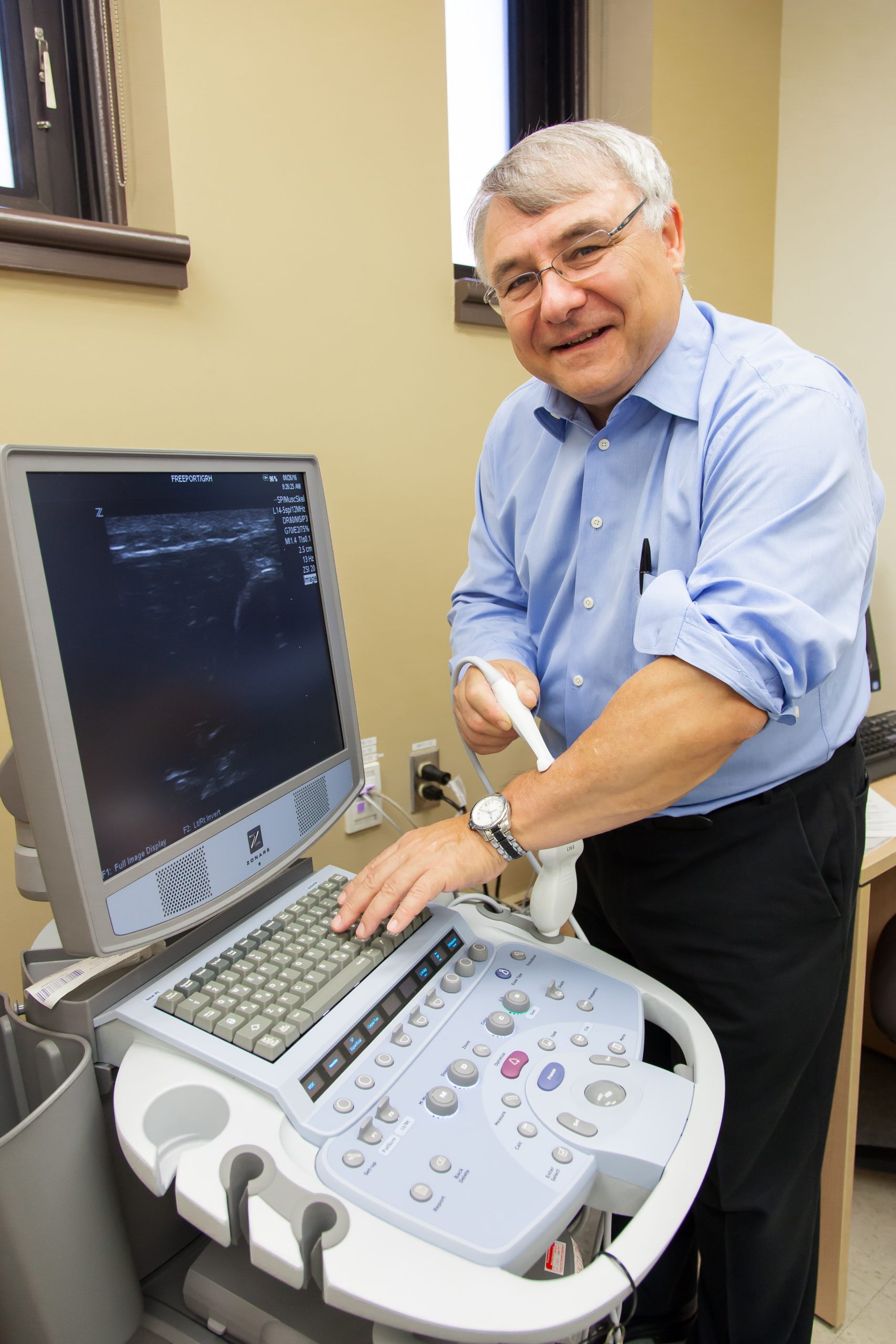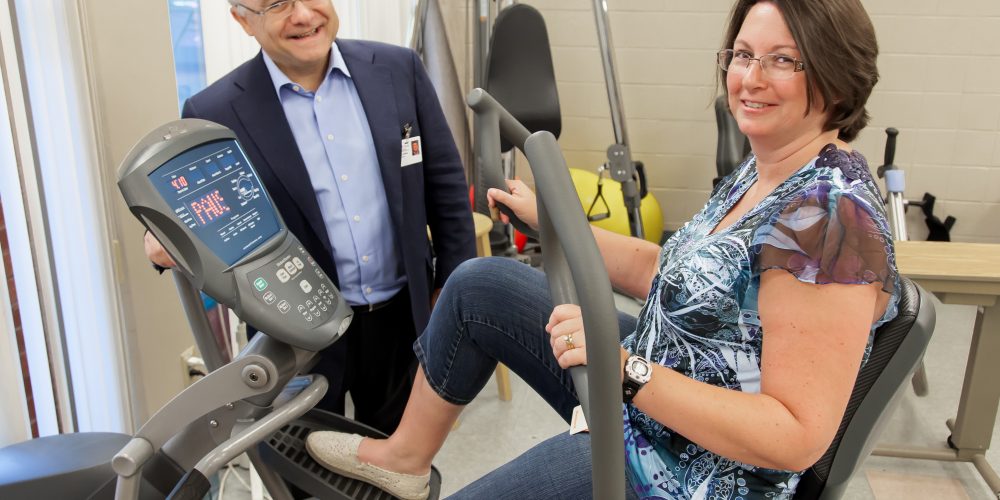Some day, for reasons big or small, everyone ends up using services at a local hospital.
With that in mind, Dr. Doug Dittmer, Medical Director of Rehabilitation at Grand River Hospital in Kitchener, Ontario, began asking, “Why shouldn’t it be the best experience possible?”
Some day, for reasons big or small, everyone ends up using services at a local hospital.
With that in mind, Dr. Doug Dittmer, Medical Director of Rehabilitation at Grand River Hospital in Kitchener, Ontario, began asking, “Why shouldn’t it be the best experience possible?”
Today, thanks to Dittmer’s curiosity and insights, medical professionals, academics and entrepreneurs are exploring that concept with a shared sense of purpose. If plans fall into place, the next step will be a med-tech innovation hub in a heritage building with deep roots in Waterloo Region.
Dittmer’s journey of discovery began at Communitech, a not-for-profit tech-innovation hub just a few blocks from the hospital, where university grads, entrepreneurs and other companies harness technological innovations, many of them modernizing health care.
“It struck me that there was this huge abyss between engineers and computer scientists and kinesiologists and doctors and nurses and therapists,” Dittmer says.
“As I began to look into it more, I began to understand how powerful the University of Waterloo, Laurier and Conestoga College are here – and that (the hospital) really never had the chance to work closely with them.”
He started going to tech seminars where he was “blown away” by research being done – especially inventions the hospital could adopt to improve the overall patient experience.
“Then, one of the presenters was talking about prosthetics, and he was talking about people overseas who step on a landmine and lose a leg,” Dittmer recalls.
“He said they don’t have prosthetics there, but they do have CAT scans at the hospital, so they were able to make an image of the opposite leg – the leg that survived the bomb blast – and he would then send that (image) back to Canada.”
“They would re-jig it so they could actually – with a 3D printer – build a prosthesis for the other side that would exactly match,” he says.
Dittmer was both amazed and bewildered that in the heart of Canada’s tech sector, his rehabilitation department wasn’t utilizing this modern technology.
He then learned how other companies were sharing data with cloud technology, and still others were downsizing traditional medical devices using nanotechnology to make them more mobile and efficient.
“Doctors and nurses and therapists are pretty smart people within our field, but we’re not aware of all the wonderful things in the technology world. So by teaming us up with computer scientists and kinesiologists, you get a whole different perspective,” he says.
“We just didn’t know these tools existed… You feel like a schmuck, but really, the answers are there; we just didn’t know how to tap into it.”
So Dittmer – who says he is known for his “crazy” approach to tackling seemingly impossible challenges – spearheaded the hospital’s technological movement by building on and creating new relationships within the community.
Last spring, he chaired a daylong symposium called Waterloo Region Med Tech: Bridging the Gap 2016, organized through partnerships between the hospital and Communitech, the Centre for Biotechnology and Bioengineering at the University of Waterloo, and the Waterloo Wellington Local Health Integration Network.
Now Dittmer is immersed in plans for a med-tech innovation hub in an empty heritage building at Grand River Hospital’s Freeport Campus. By fostering those relationships made at the conference last spring, he has launched a working group to obtain a range of perspectives on how to move forward and best sort out all the details.
“The group consists of the entire community,” he says. “There are representatives from the university, colleges, politicians, engineers, and more.”

Dr. Doug Dittmer operates a sonogram transducer on his arm. Photo by Tomasz Adamski.
While it’s still a working concept, Dittmer’s goal for the med-tech hub is to invite locals – students and professionals – to bring tech ideas and inventions to Freeport, to enhance and modernize health care technologies, all on site. Innovators will not only have access to technical resources but also valuable medical insights from patients and health care workers who will be using the new technology. Those perspectives, along with the proximity to others working on medical technology, will be key to understanding a product’s functionality and, ultimately, how it will help health care progress. Access to that kind of feedback and testing on real patients is not currently available.
Dittmer is hopeful the centre will receive provincial funding since Ontario’s Chief Health Innovation Strategist William Charnetski has praised the way Waterloo Region’s health care and technology professionals have come together to collaborate with a clear endgame in mind.
“It’s a matter of putting the pieces together through grant applications and then nurturing the growing partnerships,” Dittmer adds.
“I don’t think we’re going to be struggling for people knocking on our door,” he says. “I think it’s going to be the other way around. I think there’s this pent-up demand in the community, that as soon as we get this thing up and running, I would be shocked if we’re not pretty busy.”
The med-tech innovation hub will be located in what was originally a residence for nurses-in-training when Freeport opened as a sanitorium for tuberculosis patients 100 years ago. These days Freeport not only houses Dittmer’s rehabilitation department but also services that range from long-term mental health and complex continuing care, to mammography and a satellite dialysis unit.
“We have this old building here – about 9,000 to 10,000-square-feet – that was empty, and it was a heritage building, so we couldn’t knock it down,” he says. “It provided some unique space.”
Dittmer, accompanied by a cross-disciplinary range of deans from local post-secondary institutions, did a walk-through to see if it was a good place for medical trials and technological experiments. “We walked through it and our eyes popped out of our head, and we said, ‘This is it,’ ” he recalls. “They said, ‘I think the grad students would love working here.’ ”
The group was pleased to find an existing structure, saving them the cost of building a new one. They also liked the fact students could learn, work and create in an environment they will someday be benefiting.
And then, rather quickly, it all started coming together. Once the med-tech innovation hub is up and running, Waterloo Region will have a unique environment where multidisciplinary teams of medical doctors and med-tech creatives will work together with patients who can provide immediate feedback. The feedback loop gets bigger when the entrepreneurs and other companies become involved.
For Iain Klugman, Communitech’s Chief Executive Officer, the region’s boom in medical-health startups comes down to local businesses’ achieving their triple bottom line.
“People build companies based on their understanding of value chains,” Klugman says. “One of the things that’s happening in our country is that there’s an opening up and a greater understanding of health care as a platform, as a value chain.”
With better understanding of the health sector, tech professionals now understand there are opportunities to make money and create, while adding value to the industry and society as a whole.
“I think the other thing we’re seeing is that a lot of the interest in companies who are starting right now have a triple bottom line,” Klugman says.
That triple bottom line framework typically includes a social, financial, ecological or environmental gains, which are often closely intertwined. In the case of Waterloo Region, Krugman says that socially, med-tech companies are working to better society through access to better health care. There is money to be made, and if successful the third profit is that it betters the environment – or in this case, may extend or better the life of the user. Klugman adds, “You see a lot of people who are building products which are about reducing infection from operations, or being able to identify diabetes earlier, or being able to do eye-testing in rural Africa.”
He says the local tech sector is also seeing a lot more hardware companies with a focus on bettering the medical world.
“Almost 50 percent of the companies we’re working with these days that are coming up are hardware companies. Really, hardware is the intersection,” Klugman says, citing wearable technology as an example of that merger.
Other local examples include Intellijoint Surgical’s hip placement device, which ensures accuracy during replacement surgery, or Avenir Medical’s orthopedic medical instruments.
“There are also these programs at the University of Waterloo that are at the intersection between disciplines,” he says. “So you look at bio-mechanical engineering; you look at mechatronics, which is mechanical-electrical; you look at nano, which is chemistry; and nano materials, engineering. So you see companies at the intersection of things, which are tied in the world between hardware and software.”
It’s that niche crossover between disciplines that has students and young professionals excited to put down roots and collaborate with local institutions such as Grand River Hospital.
While there’s still plenty of work going on behind the scenes to get the med-tech innovation hub from the bench to clinical trials, Dittmer says he’s optimistic it will be up and running within five years.
Though the health care sector doesn’t have a lot of money to throw around, Dittmer says there is a return on investment for hospitals implementing technological innovations, even small ones.
One example, he says, occurred in Chatham, when the hospital purchased mobile phones for their cleaning staff.
Before the purchase, beds could remain empty for a full day while administrators tried to reach cleaning staff – and patients waited. With mobile phones, administrators were able to have the room cleaned immediately, improve speed of service and increase overall productivity – all, Dittmer says, because of a small investment in technology.
By embracing technologies, hospitals can find efficiences while the broader community gains new jobs, Dittmer says.
“We’re about to do something that has not been done anywhere in Canada,” he says. “There are tech centres around Canada, but the concept we have – the opportunity that we have to bring together universities, Communitech, accelerators, colleges, politicians, hospitals – that is really unique.”
Of the 1,000 companies linked to Communitech, about 20 per cent – 200 companies – are working on health care products.
“So if we were working with that many companies, imagine what we could do. Imagine,” Dittmer says.
“Put that together with the engineering minds and computer sciences and kinesiologists and nanotechnologists. Now these industrial companies have access to that kind of brain power, and you say, ‘Well, we’d like to do a clinical trial. Can you facilitate that?’ It’s magical.”
Laurie Snell is a political science graduate from UBC and a journalism graduate from Conestoga College. She has extensive experience with multimedia reporting and is currently working as a freelance copywriter.













